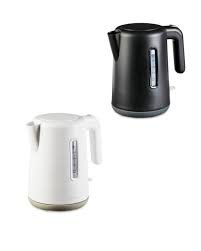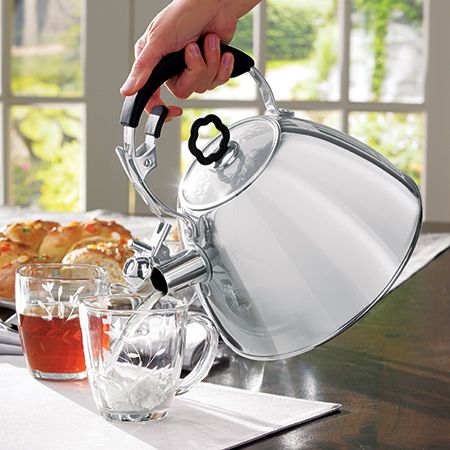To clean a Chefman Electric Kettle, fill it with equal parts water and vinegar, bring to a boil, let it sit for an hour, then rinse and dry thoroughly. When it comes to maintaining your Chefman Electric Kettle, regular cleaning is essential for ensuring the purity and flavor of your hot beverages.
Over time, mineral deposits and impurities can accumulate inside the kettle, affecting the taste of your drinks. In this guide, we will walk you through the simple steps to clean your Chefman Electric Kettle effectively and efficiently. By following these instructions, you can keep your kettle in pristine condition and enjoy delicious, untainted hot drinks every time.
Let’s dive in and learn how to clean your Chefman Electric Kettle to maintain its optimal performance and extend its lifespan.
Impact Of Proper Maintenance On Kettle Longevity
Proper maintenance is essential for prolonging the longevity of a Chefman electric kettle. Regular cleaning, descaling, and rinsing after each use can prevent mineral buildup inside the kettle, ensuring optimal performance for years to come. This simple maintenance routine can help maintain the kettle’s efficiency and extend its lifespan.
Impact of Proper Maintenance on Kettle Longevity Keeping your Chefman electric kettle clean and well-maintained is crucial for its longevity. Ignoring maintenance can lead to limescale buildup and other issues that can impact the performance and lifespan of your kettle. By understanding the effects of limescale buildup and learning how to properly clean your electric kettle, you can ensure its longevity and optimal functionality. Limescale Buildup and Its Effects Limescale, a white chalky deposit that results from the minerals in hard water, can accumulate on the heating element and interior surfaces of your kettle over time. This buildup can negatively impact the efficiency and lifespan of your kettle. Limescale can lead to reduced heating efficiency, causing your kettle to take longer to boil water and consume more energy. Additionally, it can affect the taste and quality of the water by imparting a mineral taste to your beverages. Proper maintenance and regular descaling can help prevent limescale buildup and ensure that your Chefman electric kettle continues to perform optimally. By following these simple maintenance steps, you can extend the lifespan of your kettle and enjoy a consistently great cup of tea or coffee without any undesirable flavor or odors. Remember that taking proper care of your electric kettle not only ensures its longevity but also provides you with a reliable and efficient appliance for daily use. Regular cleaning and descaling are essential for maintaining the performance and lifespan of your kettle, helping you avoid the negative effects of limescale buildup and ensuring a better overall experience. When it comes to maintenance, prevention is key. By incorporating regular cleaning and descaling into your routine, you can protect your kettle from limescale buildup and its negative effects, ensuring that it continues to function optimally for years to come.
Credit: m.youtube.com
How To Prepare The Kettle For Cleaning
Disconnecting The Kettle From The Power Source
Prior to cleaning your Chefman electric kettle, make sure to disconnect it from the power source. Unplug the kettle from the electrical outlet to avoid any potential hazards during the cleaning process.
Letting The Kettle Cool Down
After using the kettle, it is essential to let it cool down before initiating the cleaning procedure. The hot surface of the kettle may cause burns if not handled with caution. Allow the kettle to reach a safe temperature before proceeding with the cleaning steps.
Cleaning The Exterior Of The Kettle
To clean the exterior of the Chefman Electric Kettle, use a damp cloth and mild detergent to wipe away any stains or dirt. Gently scrub the surface and then rinse with water. Dry the kettle thoroughly before plugging it in.
Regular cleaning will keep your kettle looking fresh and hygienic.
Cleaning the exterior of your Chefman electric kettle is essential to keep it looking pristine and functioning smoothly. By following these simple steps, you can maintain the cleanliness of your kettle and ensure a prolonged lifespan.Using Gentle Cleaning Agents
When cleaning the exterior of your Chefman electric kettle, it’s important to use gentle cleaning agents to avoid damaging the surface. Mild dish soap and a soft sponge or cloth are ideal for removing any stains or residue. Avoid using abrasive scrubbers or harsh chemicals, as they can scratch the surface or cause discoloration. Proper Drying Techniques After cleaning the exterior of the kettle, it’s crucial to dry it thoroughly to prevent water spots or rust from forming. Use a clean, dry cloth to gently pat the surface until all moisture is removed. Allow the kettle to air dry completely before using it again to avoid trapping any residual moisture inside. Incorporating these cleaning methods into your routine will not only keep your Chefman electric kettle looking its best but also ensure that it continues to function optimally for years to come.Descaling The Interior Of The Kettle
Descaling the interior of your Chefman electric kettle is essential for maintaining its performance and ensuring the longevity of the appliance. Over time, mineral deposits from water can build up inside the kettle, affecting both the taste of your beverages and the efficiency of the heating element. With the right descaling method, you can easily remove these deposits and keep your kettle in top condition. Here’s how to effectively descale the interior of your Chefman electric kettle.
Vinegar Or Lemon Juice: Best Natural Descaling Agents
When it comes to descaling your Chefman electric kettle, natural descaling agents like vinegar and lemon juice are highly effective. These common kitchen ingredients contain natural acids that can dissolve mineral buildup without the use of harsh chemicals. To descale with vinegar or lemon juice, follow these simple steps:
- Fill the kettle with a mixture of equal parts water and vinegar or lemon juice.
- Allow the solution to sit in the kettle for at least an hour to effectively break down the mineral deposits.
- After soaking, rinse the kettle thoroughly with clean water to remove the loosened scale and any residual odor.
This natural descaling method is not only environmentally friendly but also a cost-effective solution for maintaining your kettle’s performance.
Rinse And Repeat: Ensuring Residue-free Interior
After descaling the interior of your Chefman electric kettle, it’s important to ensure that no residue is left behind from the descaling agent. Residual vinegar or lemon juice can affect the taste of your brewed beverages if not thoroughly rinsed. To ensure a residue-free interior, follow these steps:
- Fill the kettle with clean water and bring it to a boil.
- Pour out the boiled water and repeat the process with fresh water at least two to three times to ensure any remaining residue is completely removed.
This additional rinsing step will help guarantee that your Chefman electric kettle is free from any lingering taste or odor before using it to prepare your favorite hot drinks.
Preventive Measures To Reduce Frequency Of Descaling
When it comes to keeping your Chefman Electric Kettle in top condition, implementing preventive measures is essential to reduce the frequency of descaling. By taking proactive steps, you can maintain the efficiency and longevity of your electric kettle, saving time and effort in the long run.
Distilled Water Vs. Tap Water
Using the right type of water can play a significant role in minimizing the need for descaling. Distilled water is the ideal choice as it contains fewer minerals and impurities compared to tap water. Since tap water can leave mineral deposits in the kettle, leading to scaling, opting for distilled water can help reduce the buildup and extend the time between cleaning sessions.
Regular Cleaning Schedule: Is There An Ideal Frequency?
Establishing a regular cleaning schedule is crucial for maintaining the performance of your Chefman Electric Kettle. While the ideal frequency may vary based on usage and water quality, a general recommendation is to clean the kettle thoroughly at least once a month. However, if you notice signs of scaling or taste changes in the water, it’s advisable to increase the cleaning frequency to prevent any buildup that could affect the kettle’s functionality.
Performing A Boil Test: Ensuring No Residue Or Odor
When cleaning your Chefman electric kettle, performing a boil test is essential to ensure that no residue or odor remains, allowing you to enjoy pure and clean-tasting water. By following simple steps, you can effectively confirm that your kettle is operating at its best.
Pouring Out The Initial Boiled Water
After cleaning your electric kettle, fill it with water up to the maximum fill line. Boil the water normally and then carefully pour out the boiled water to eliminate any remaining cleaning solution or debris. Remember to discard the initial boiled water to ensure a fresh start.
Confirming Clean Operation
To confirm that your electric kettle is free of residue and odor, boil a fresh batch of water. Once the water has boiled, observe and smell the water to ensure there are no unusual odors or residues. This step verifies that the cleaning process has been successful and that your kettle is ready for everyday use. Regularly perform this simple test to keep your kettle clean and functioning optimally.
Frequently Asked Questions Of How To Clean A Chefman Electric Kettle
How Often Should I Clean My Chefman Electric Kettle?
It is recommended to clean your Chefman Electric Kettle every 1-2 months to prevent mineral buildup and maintain its performance. Regular cleaning also ensures that your beverages taste fresh and free from any impurities.
What Is The Best Method To Descale The Electric Kettle?
The best method to descale your Chefman Electric Kettle is by using a mixture of equal parts water and white vinegar. Fill the kettle, let the solution sit for an hour, then boil and rinse with clean water. This effectively removes mineral deposits and scales.
Can I Use A Dishwasher To Clean My Chefman Electric Kettle?
No, it is not recommended to clean your Chefman Electric Kettle in a dishwasher as the heat and harsh detergents can damage the kettle’s components. It’s best to hand wash the exterior with a soft cloth and mild detergent for optimal maintenance.
Conclusion
In a nutshell, keeping your Chefman electric kettle clean is essential for maintaining its performance and prolonging its lifespan. By following the simple steps outlined in this guide, you can ensure that your kettle remains free from limescale and mineral deposits, allowing you to enjoy clean and fresh-tasting water with every use.
Regular cleaning not only ensures the longevity of your appliance but also contributes to a better overall experience.




